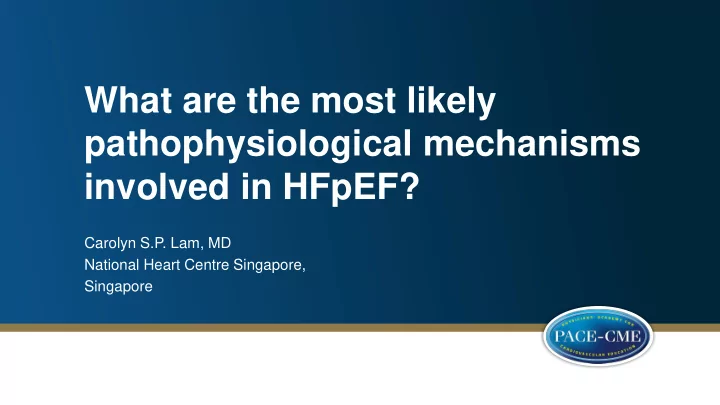

What are the most likely pathophysiological mechanisms involved in HFpEF? Carolyn S.P. Lam, MD National Heart Centre Singapore, Singapore
HFpEF Lam, Voors, de Boer, Solomon, van Veldhuisen Eur Heart J 2018
Hemodynamic targets Lam, Voors, de Boer, Solomon, van Veldhuisen Eur Heart J 2018
LV diastolic dysfunction Population-based age-, sex-, body size- adjusted Lam Circulation 2007
Left atrial hypertension: REDUCE-LAP HF I (Phase 2) Shah Circulation 2017
Pulmonary Hypertension High prevalence & prognostic impact of PH in HFpEF suggest an important pathophysiologic role Lam C.S. et al J Am Coll Cardiol. 2009;53:1119-26
Pulmonary hypertension: CHAMPION Philip B. Adamson et al. Circ Heart Fail. 2014
Role for SGLT2i: EMPEROR-Preserved Mechanism 1 − 4 Possible cardio−renal effects 5,6 SGLT2 inhibition 1,2 CV/renal outcomes observed in EMPA-REG OUTCOME 7,8 Cardiac function Osmotic Preload diuresis Afterload Cardiometabolic efficiency Metabolism CV death Arrhythmia Glucose removal Na+ Hospitalisation Sodium Arterial wall removal for heart failure structure/function Renal function Renal events 1. Heise T et al. Diabetes Obes Metab 2013;15:613; 2. Heise T et al. Clin Ther 2016;38:2265; 3. Ferrannini G et al. Diabetes Care 2015;38:1730; 4. Briand F et al. Diabetes 2016;65:2032; 5. Heerspink HJ et al. Circulation 2016;134:752; 6. Inzucchi S et al. Diab Vasc Dis Res 2015;12:90; 7. Zinman B et al. N Engl J Med 2015;373:2117; 8. Wanner C et al. N Engl J Med 2016;375:323
Molecular targets Lam, Voors, de Boer, Solomon, van Veldhuisen Eur Heart J 2018
Microvascular dysfunction in heart failure with preserved ejection fraction (HFpEF): Evidence from PROMIS-HFpEF Carolyn S. P. Lam, Sanjiv J. Shah, Sara Svedlund, Antti Saraste, Camilla Hage, Ru San Tan, Maria Lagerström Fermer, Malin A. Broberg, Li-Ming Gan, Lars H. Lund National Heart Centre Singapore & Duke-National University of Singapore (CSPL, RST); University Medical Centre Groningen, the Netherlands (CSPL); Division of Cardiology, Department of Medicine, Northwestern University Feinberg School of Medicine, Chicago, IL, USA (SJS and LBN); Department of Clinical Physiology, Institute of Medicine, Sahlgrenska University Hospital, University of Gothenburg, Gothenburg, Sweden (SS); Heart Center, Turku University Hospital and University of Turku, Turku, Finland (AS); Cardiology Unit and Heart and Vascular Theme, Karolinska Institutet, Department of Medicine, Stockholm, Sweden (CH and LL); Cardiovascular, Renal and Metabolism Translational Medicines Unit, Early Clinical Development, IMED Biotech Unit, AstraZeneca, Gothenburg, Sweden (MLF, MAB, and LMG); Department of Molecular and Clinical Medicine, Institute of Medicine, Sahlgrenska Academy at the University of Gothenburg, Gothenburg, Sweden and Department of Cardiology, Sahlgrenska University Hospital, Gothenburg, Sweden (LMG)
PROMIS-HFpEF - Aims: Prospective multicenter PRevalence Of Microvascular dySfunction in HFpEF study To investigate the prevalence of CMD and its association with systemic endothelial dysfunction, HF severity, and myocardial dysfunction in a well-defined, prospective HFpEF population using a comprehensive functional imaging approach
PROMIS-HFpEF - Methods • Coronary flow reserve (CFR) by transthoracic Doppler echo coronary flow velocity at rest and with adenosine - Read by core lab - CMD defined as CFR<2.5 • Systemic microvascular function by peripheral arterial tonometry (EndoPAT) reactive hyperemia index (RHI) • Myocardial function by echo tissue Doppler and speckle-tracking
PROMIS-HFpEF - Results Prevalence of CMD among 202 HFpEF with CFR = 75% (95% CI 69-81%) • Mean (SD) CFR = 2.13 (0.51) • Median (IQR) CFR = 2.08 (1.78-2.50) CFR attempted in 233;successful in 87%
PROMIS-HFpEF - Results After multivariable adjustment 1 worse CFR was related to: • higher UACR & NT-proBNP • lower RHI, TAPSE, RV strain 1 for age, sex, body mass index, atrial fibrillation, diabetes, revascularized coronary disease, smoking, left ventricular mass, study site
PROMIS-HFpEF: Conclusions • Largest prospective multicenter study of CMD in HFpEF • High (75%) prevalence of CMD in HFpEF in the absence of unrevascularized macrovascular CAD • CMD is associated with HF severity (↑NT -proBNP), systemic endothelial dysfunction ( ↓ EndoPAT RHI, ↑UACR), and cardiac dysfunction (↓LV, LA, RV strain) • Microvascular dysfunction may be a promising composite risk marker and therapeutic target in HFpEF
Molecular targets Lam, Voors, de Boer, Solomon, van Veldhuisen Eur Heart J 2018
Angiotensin Receptor Neprilysin Inhibition in Heart Failure With Preserved Ejection Fraction Rationale and Design of the PARAGON-HF Trial
Molecular targets Lam, Voors, de Boer, Solomon, van Veldhuisen Eur Heart J 2018
HFpEF Lam, Voors, de Boer, Solomon, van Veldhuisen Eur Heart J 2018
Recommend
More recommend